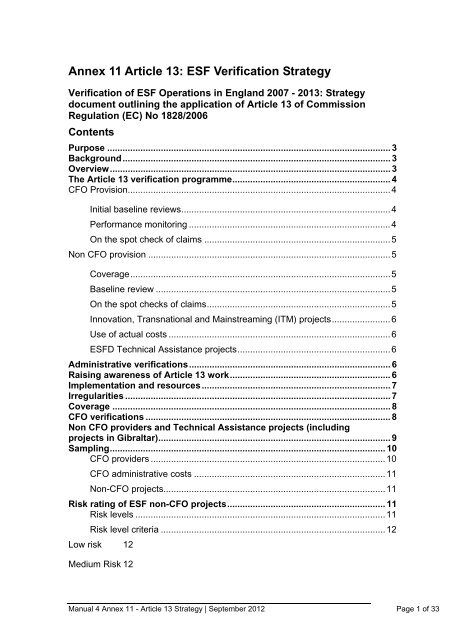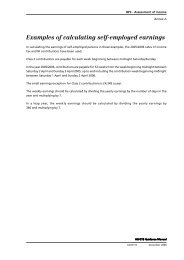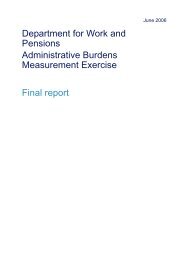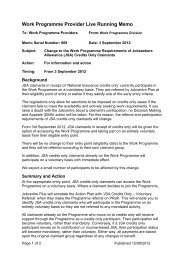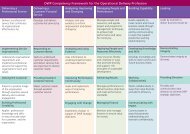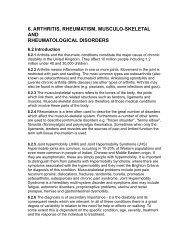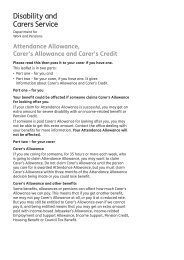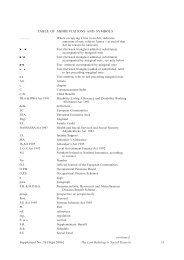ESF Guidance Manual 4 Annex 11: Article 13: ESF Verification ...
ESF Guidance Manual 4 Annex 11: Article 13: ESF Verification ...
ESF Guidance Manual 4 Annex 11: Article 13: ESF Verification ...
You also want an ePaper? Increase the reach of your titles
YUMPU automatically turns print PDFs into web optimized ePapers that Google loves.
<strong>Annex</strong> <strong>11</strong> <strong>Article</strong> <strong>13</strong>: <strong>ESF</strong> <strong>Verification</strong> Strategy<br />
<strong>Verification</strong> of <strong>ESF</strong> Operations in England 2007 - 20<strong>13</strong>: Strategy<br />
document outlining the application of <strong>Article</strong> <strong>13</strong> of Commission<br />
Regulation (EC) No 1828/2006<br />
Contents<br />
Purpose ............................................................................................................... 3<br />
Background......................................................................................................... 3<br />
Overview.............................................................................................................. 3<br />
The <strong>Article</strong> <strong>13</strong> verification programme.............................................................. 4<br />
CFO Provision.......................................................................................................4<br />
Initial baseline reviews..................................................................................4<br />
Performance monitoring ...............................................................................4<br />
On the spot check of claims .........................................................................5<br />
Non CFO provision ...............................................................................................5<br />
Coverage......................................................................................................5<br />
Baseline review ............................................................................................5<br />
On the spot checks of claims........................................................................5<br />
Innovation, Transnational and Mainstreaming (ITM) projects.......................6<br />
Use of actual costs .......................................................................................6<br />
<strong>ESF</strong>D Technical Assistance projects............................................................6<br />
Administrative verifications............................................................................... 6<br />
Raising awareness of <strong>Article</strong> <strong>13</strong> work............................................................... 6<br />
Implementation and resources.......................................................................... 7<br />
Irregularities ........................................................................................................ 7<br />
Coverage ............................................................................................................. 8<br />
CFO verifications ................................................................................................ 8<br />
Non CFO providers and Technical Assistance projects (including<br />
projects in Gibraltar)........................................................................................... 9<br />
Sampling............................................................................................................ 10<br />
CFO providers ............................................................................................10<br />
CFO administrative costs ...........................................................................<strong>11</strong><br />
Non-CFO projects.......................................................................................<strong>11</strong><br />
Risk rating of <strong>ESF</strong> non-CFO projects.............................................................. <strong>11</strong><br />
Risk levels ..................................................................................................<strong>11</strong><br />
Risk level criteria ........................................................................................12<br />
Low risk 12<br />
Medium Risk 12<br />
<strong>Manual</strong> 4 <strong>Annex</strong> <strong>11</strong> - <strong>Article</strong> <strong>13</strong> Strategy | September 2012 Page 1 of 33
High Risk <strong>13</strong><br />
Quality assurance ............................................................................................. 14<br />
Quality assurance procedures......................................................................... 14<br />
Monitoring ......................................................................................................... 14<br />
Reporting........................................................................................................... 14<br />
Cooperation with the Certifying Authority...................................................... 15<br />
Cooperation with audits ................................................................................... 15<br />
Review of <strong>Article</strong> <strong>13</strong> verification strategy ....................................................... 15<br />
Appendix ........................................................................................................... 16<br />
<strong>Manual</strong> 4 <strong>Annex</strong> <strong>11</strong> - <strong>Article</strong> <strong>13</strong> Strategy | September 2012 Page 2 of 33
Purpose<br />
1. This strategy document, prepared by the <strong>ESF</strong> England and Gibraltar<br />
Managing Authority, sets out the requirements, actions, responsibilities and<br />
timescales involved in delivering the obligations under <strong>Article</strong> <strong>13</strong> of<br />
Commission Regulation (EC) No 1828/2006 for <strong>ESF</strong> in England and Gibraltar<br />
for the 2007- 20<strong>13</strong> programme.<br />
Background<br />
2. The Managing Authority is required to ensure that expenditure declared by<br />
beneficiaries has been incurred and complies with community and national<br />
rules in accordance with <strong>Article</strong> 60 of the general regulation and <strong>Article</strong> <strong>13</strong> of<br />
the implementing regulation.<br />
3. <strong>Article</strong> <strong>13</strong>(4) of Regulation (EC) No 1828/2006 requires that the Managing<br />
Authority establishes written standards and procedures for both the<br />
administrative and on-the-spot verifications and keeps records for each<br />
verification, stating the work performed, the date and results of the<br />
verification, and the measures taken in respect of irregularities detected.<br />
4. This verification strategy document draws on European Commission<br />
guidance, specifically, COCOF 08/0020/00 EN Working document concerning<br />
good practice in relation to management verifications to be carried out by<br />
Member States on projects co-financed by the Structural Funds and the<br />
Cohesion Fund for the 2007 –20<strong>13</strong> programming period (31-03-2008).<br />
Overview<br />
5. Management verifications are part of the internal control system of any well<br />
managed organisation. They are the normal day to day controls made by<br />
management within an organisation to ensure that the processes for which it<br />
is responsible are being properly carried out.<br />
6. The Managing Authority is responsible for managing and implementing<br />
operational programmes in accordance with the principle of sound financial<br />
management, and in particular for:-<br />
• ensuring that operations are selected for funding in accordance with the<br />
criteria applicable to the operational programme and that they comply with<br />
the applicable Community and national rules for the whole of the<br />
implementation period;<br />
• verifying that the co-financed products and services are delivered and that<br />
the expenditure declared by the beneficiaries for operations has actually<br />
been incurred and complies with Community and national rules;<br />
• ensuring that the Certifying Authority receives all necessary information on<br />
the procedures and verifications carried out in relation to expenditure for<br />
the purpose of certification; and<br />
• ensuring compliance with the obligations concerning information and<br />
publicity.<br />
<strong>Manual</strong> 4 <strong>Annex</strong> <strong>11</strong> - <strong>Article</strong> <strong>13</strong> Strategy | September 2012 Page 3 of 33
7. The <strong>ESF</strong> <strong>Article</strong> <strong>13</strong> verification strategy covers control arrangements for Co<br />
Financing Organisations (the vast majority of <strong>ESF</strong> provision in England) and<br />
non CFO beneficiaries including Direct Delivery projects in Convergence and<br />
Phasing in areas, Technical Assistance, Innovation Transnational and<br />
Mainstreaming and projects in Gibraltar. In addition, the Managing Authority<br />
will prepare an <strong>Article</strong> <strong>13</strong> Delivery Plan that sets out a detailed programme of<br />
verification activity.<br />
8. Activity in the <strong>Article</strong><strong>13</strong> strategy and delivery plan will ensure that <strong>ESF</strong><br />
expenditure declared to the Commission complies with:-<br />
• the <strong>ESF</strong> Operational Programme (or in the case of Technical Assistance<br />
the national strategy);<br />
• the beneficiary agreement / memorandum of understanding, CFO plan or<br />
non CFO application; and<br />
• community and national rules including <strong>ESF</strong> eligibility, procurement<br />
requirements, state aid rules, cross cutting themes and publicity.<br />
9. In addition, the <strong>Article</strong> <strong>13</strong> verification strategy will:-<br />
• establish a framework within which the verification work will be delivered<br />
on a consistent basis;<br />
• inform and explain to beneficiaries the rationale for the work, its<br />
importance and the reasons behind specific requests and obligations;<br />
and<br />
• establish the verification activity within the overall framework of<br />
management and control activity for <strong>ESF</strong> in England and Gibraltar.<br />
10. In addition to this strategy document and the <strong>Article</strong> <strong>13</strong> delivery plan,<br />
detailed procedures, guidance and proformas are included in the Managing<br />
Authority <strong>Manual</strong> available on the <strong>ESF</strong> web site.<br />
The <strong>Article</strong> <strong>13</strong> verification programme<br />
<strong>11</strong>. The <strong>Article</strong> <strong>13</strong> <strong>ESF</strong> verification programme in England covers the following<br />
key elements:-<br />
CFO Provision<br />
Initial baseline reviews<br />
12. Prior to the receipt of initial claims the Managing Authority will build up a<br />
comprehensive understanding of the operation of individual CFOs. The<br />
Managing Authority (with the Greater London Authority – GLA - in London) will<br />
undertake an initial base-line review with each CFO to focus on procurement,<br />
<strong>ESF</strong> supporting systems, separate accounting for <strong>ESF</strong>, management<br />
information, match funding and reporting requirements. A baseline report,<br />
agreed with the CFO with action points where appropriate, will be issued.<br />
Performance monitoring<br />
<strong>13</strong>. CFO performance will be subject to quarterly review by the Managing<br />
Authority. The review of performance will cover key areas such as<br />
<strong>Manual</strong> 4 <strong>Annex</strong> <strong>11</strong> - <strong>Article</strong> <strong>13</strong> Strategy | September 2012 Page 4 of 33
procurement, spend, participant progress, progress against output and results<br />
targets, publicity, cross-cutting themes and state aid rules.<br />
On the spot check of claims<br />
14. The Managing Authority will undertake on the spot checks of interim<br />
claims for every CFO. This check will verify expenditure claimed against CFO<br />
contract cost payments to providers, other provider payments and actual<br />
expenditure claimed for CFO administration costs. Each on the spot check will<br />
select a minimum of 20 per cent of claimed expenditure for detailed<br />
verification.<br />
15. As a key element of the verification of CFO claims, the Managing<br />
Authority will undertake selected on the spot verification visits to DWP prime<br />
contractors and their sub-contractors, Skills Funding Agency providers and<br />
sub-contractors/partners if relevant, NOMS contractors and their subcontractors<br />
and other CFO providers. Provider and sub-contractor visits verify<br />
that the services agreed in their contracts have been delivered and<br />
correspond to expenditure claimed by CFOs in their interim claims to the<br />
Managing Authority. On-the-spot verifications also confirm existence of<br />
participants and compliance with other <strong>ESF</strong> requirements including publicity<br />
and the cross-cutting themes.<br />
16. All CFOs will be subject to on the spot financial checks. A random<br />
selection process will be used to select the expenditure that will make up the<br />
20 per cent check. The overall approach to the selection of providers for on<br />
the spot checks is set out below in the sampling section. Copies of the <strong>Article</strong><br />
<strong>13</strong> proformas used for the on the spot CFO verification visit and the on the<br />
spot monitoring of contractors and sub-contractors activity are included in the<br />
Managing Authority <strong>Manual</strong>.<br />
Non CFO provision<br />
Coverage<br />
17. <strong>Article</strong><strong>13</strong> control arrangements will also be applicable to non CFO<br />
delivered <strong>ESF</strong> provision (projects in Gibraltar, Technical Assistance, some<br />
non CFO activity in convergence and phasing in regions and innovation and<br />
transnationality projects).<br />
Baseline review<br />
18. All non CFO projects will receive an initial ‘baseline’ monitoring visit from<br />
the Managing Authority. The purpose of these initial visits is to ensure that<br />
appropriate systems and procedures are in place at an early stage, preferably<br />
prior to any initial interim claims. A baseline report, agreed with the provider<br />
with action points where appropriate, will be issued.<br />
On the spot checks of claims<br />
19.Every non CFO and TA project will be subject to an on the spot financial<br />
check covering their first year or more of operation. The frequency of<br />
subsequent on the spot checks will be determined by the findings of the<br />
<strong>Manual</strong> 4 <strong>Annex</strong> <strong>11</strong> - <strong>Article</strong> <strong>13</strong> Strategy | September 2012 Page 5 of 33
earlier baseline review and subsequent on the spot visit. Projects will be<br />
rated as high, medium or low risk for financial monitoring purposes (see<br />
paragraphs 40 to 50 for more detail). High risk projects will receive more<br />
frequent visits that may focus on issues of concern and may not necessarily<br />
adopt the standard procedures set out here for on the spot checks.<br />
Innovation, Transnational and Mainstreaming (ITM) projects<br />
20. Innovation, Transnational and Mainstreaming (ITM) projects are<br />
considered to be more complex than other non-CFO projects and the<br />
expectation is that they will receive on the spot visits on a twelve monthly<br />
basis (subject to the provision of claims for checking). The Managing Authority<br />
has delegated the responsibility for on the spot checks for ITM projects to the<br />
ITM Unit in Birmingham. The Managing Authority has agreed procedures for<br />
the operation of ITM spot checks with the ITM Unit. The Managing Authority<br />
will monitor and review the ITM Unit <strong>Article</strong> <strong>13</strong> activities.<br />
Use of actual costs<br />
21. All non CFO expenditure is based on actual rather than contract costs and<br />
<strong>Article</strong><strong>13</strong> controls of non CFO provision will reflect this. Control visits will<br />
check expenditure included in interim claims against supporting documents<br />
and invoices. Under each <strong>ESF</strong> cost heading (staff, participant and other) five<br />
items of expenditure, where available, will be selected at random (using a<br />
random number generated selection process) for checking. Items selected will<br />
cover more than one interim claim period (if available). For ITM projects,<br />
additional items of expenditure covering transnational costs will be selected<br />
for checking. These checks will verify the eligibility of the expenditure claimed<br />
by projects and the activity supported. Copies of the <strong>Article</strong> <strong>13</strong> proformas<br />
used for non CFO and TA activity are included in the Managing Authority<br />
<strong>Manual</strong> on the <strong>ESF</strong> web site.<br />
<strong>ESF</strong>D Technical Assistance projects<br />
22. For TA projects supporting Managing Authority activity, arrangements will<br />
be put in place to ensure adequate separation of responsibilities. <strong>Article</strong> <strong>13</strong><br />
verification of MA TA projects will be undertaken by <strong>ESF</strong>D staff that have no<br />
involvement with that specific project.<br />
Administrative verifications<br />
23. The Managing Authority (including the London Intermediate Body and the<br />
Government of Gibraltar) are responsible for administrative verifications of all<br />
interim and final claims submitted by beneficiaries to check reasonableness,<br />
accuracy and probity.<br />
24. The administrative verification work is computerised. On receipt of the<br />
claim the Managing Authority or Intermediate Body will complete a standard<br />
list of certification checks. Details of the checks are set out in the Managing<br />
Authority <strong>Manual</strong>.<br />
Raising awareness of <strong>Article</strong> <strong>13</strong> work<br />
<strong>Manual</strong> 4 <strong>Annex</strong> <strong>11</strong> - <strong>Article</strong> <strong>13</strong> Strategy | September 2012 Page 6 of 33
25. An important element of the <strong>Article</strong> <strong>13</strong> verification strategy is to ensure<br />
arrangements are put in place to inform beneficiaries and make them aware<br />
of the importance of the monitoring work being undertaken by the Managing<br />
Authority.<br />
26. The verification strategy will address the need to raise awareness through<br />
the following actions:<br />
• baseline reviews with CFOs and initial visits to non CFO providers will<br />
include a short presentation on the rationale for verification and the<br />
importance of cooperating with monitoring activity;<br />
• correspondence and forms sent to beneficiaries and providers will include<br />
explanations for the monitoring visits;<br />
• final reports will be returned to all beneficiaries with action points<br />
highlighted and deadlines for completion;<br />
• the Skills Funding Agency National Office and DWP EG Provision<br />
Management Division will be closely involved in working up the verification<br />
proposals and will be a key channel to inform the Skills Funding Agency<br />
and Jobcentre plus in the regions about the work. As part of the baseline<br />
review process, ’walkthrough briefings’ of national Skills Funding Agency<br />
and DWP systems will be organised for A<strong>13</strong> MA staff;<br />
• bi-annual reports on the outcomes of verification work will be made<br />
available to key partners including all CFOs.<br />
Implementation and resources<br />
27. <strong>Article</strong> <strong>13</strong> controls will be undertaken by the Managing Authority, and for<br />
ITM projects, the ITM Unit in Birmingham. In London the performance element<br />
of the controls will be carried out by the Greater London Authority (GLA)<br />
acting as an Intermediate Body.<br />
28. Staffing in the Managing Authority and the ITM Unit includes experienced<br />
staff who have undertaken <strong>Article</strong> 4 controls in the 2000-2006 <strong>ESF</strong><br />
programme. These staff will be responsible for inducting and training new and<br />
less experienced members of the <strong>Article</strong><strong>13</strong> teams.<br />
29. Results of verification activity will be recorded and copied to CFOs and<br />
non CFO providers so that remedial action can be agreed and implemented.<br />
The Managing Authority will check that recommendations have been<br />
implemented and any irregular expenditure identified is removed from future<br />
claims.<br />
30. All reports of verification activity will be held and filed electronically in the<br />
<strong>ESF</strong> IT system and available to Managing Authority, Certifying Authority and<br />
Audit Authority staff.<br />
Irregularities<br />
31. Irregularities may be identified during the course of <strong>Article</strong> <strong>13</strong> verification<br />
work. It will be the responsibility of the officer who identified the irregularity to<br />
investigate the matter and eventually clear it. Any irregularity involving<br />
€10,000 or more must be reported to the Commission. Action on irregularities<br />
<strong>Manual</strong> 4 <strong>Annex</strong> <strong>11</strong> - <strong>Article</strong> <strong>13</strong> Strategy | September 2012 Page 7 of 33
will follow the procedures set out in the Managing Authority <strong>Manual</strong>.<br />
Extrapolation of irregularities – CFOs<br />
31a. Where A<strong>13</strong> On the Spot verification visits establish that there are<br />
irregularities within one or more subset populations being tested (such as<br />
participants with job outcomes) and they have similar characteristics (such as<br />
missing participant records), the sample will be extended. This will establish<br />
whether or not the irregularity is likely to be repeated within the rest of the<br />
subset population.<br />
If the extended sample establishes that there are similar irregularities, the<br />
principle of extrapolation will apply. The extrapolation will cover the remaining<br />
unchecked population in order to calculate the full extent of the irregularity<br />
within that subset population. A formula will be applied to extrapolate the error<br />
across the whole population under that payment type, provision and claim<br />
period. This process is also in line with A16 procedures.<br />
CFOs should also note that the impact may extend beyond the period tested<br />
to the remaining unchecked subset population, other claims or operations. If<br />
this is the case the CFO will be asked to conduct further work on the<br />
remaining population to identify any additional irregular expenditure. CFOs<br />
should inform the MA of the methodology used, subsets and periods covered<br />
by their audit activities to demonstrate the basis for any additional irregular<br />
expenditure. This work may be reviewed by the Managing and Audit<br />
Authorities.<br />
Coverage<br />
32. All CFOs and all their claims will be subject to <strong>Article</strong> <strong>13</strong> on the spot<br />
verification activity. The selection of the expenditure and providers will be<br />
undertaken on a sample basis. The Managing Authority is required to set a<br />
sample size that achieves ‘reasonable assurance as to the legality and<br />
regularity of the underlying transactions’ (extract from EC guidance).<br />
Following consultation with the Audit Authority, the sample <strong>Article</strong> <strong>13</strong> on the<br />
spot verification at CFO level aims to cover a minimum of 20 per cent of <strong>ESF</strong><br />
and match expenditure claimed, but excluding administrative costs, during the<br />
lifetime of the programme. A key principle is that all providers/sub-contractors<br />
may be the subject of an on the spot check during the lifetime of the<br />
programme. The level and frequency of verification activity is summarised in<br />
the tables below.<br />
CFO verifications<br />
<strong>Verification</strong> activity<br />
Administrative<br />
verifications<br />
On-the-spot<br />
verifications of<br />
Undertaken<br />
by<br />
GLA<br />
Managing<br />
authority<br />
Managing<br />
authority<br />
Coverage<br />
All interim and final claims will be<br />
checked<br />
All CFO interim claims will be subject<br />
to selection through the sampling<br />
<strong>Manual</strong> 4 <strong>Annex</strong> <strong>11</strong> - <strong>Article</strong> <strong>13</strong> Strategy | September 2012 Page 8 of 33
interim claims<br />
Performance reviews<br />
On-the-spot<br />
verifications of CFO<br />
providers<br />
GLA<br />
Managing<br />
authority<br />
Managing<br />
authority<br />
process. Each CFO will be subject to<br />
a rolling programme of on the spot<br />
checks. The timing will depend upon<br />
the submission of suitable and<br />
sufficient claims. Facility for more<br />
frequent verifications if necessary.<br />
Quarterly meetings between the<br />
Managing Authority and CFOs will<br />
assess progress and monitor<br />
performance.<br />
Sample verifications will be<br />
undertaken to:<br />
- DWP prime contractors<br />
- DWP prime contractor subcontractors<br />
- Skills Funding Agency providers<br />
- Skills Funding Agency subcontractors<br />
and partners if relevant<br />
- NOMS prime contractors<br />
- NOMS prime contractor subcontractors<br />
- Community Grant Co-ordinating<br />
Bodies<br />
- other CFO providers<br />
Individual contractors will be visited on<br />
the basis of a random selection<br />
process.<br />
Non CFO providers and Technical Assistance projects<br />
(including projects in Gibraltar)<br />
<strong>Verification</strong> activity<br />
Administrative<br />
verifications<br />
On-the-spot<br />
verifications of<br />
interim claims<br />
Undertaken<br />
by<br />
GLA<br />
Govt of<br />
Gibraltar<br />
Managing<br />
authority<br />
Managing<br />
authority ITM<br />
Unit<br />
Coverage<br />
All interim and final claims will be<br />
checked<br />
All projects will be subject to an initial<br />
on the spot visit. Subsequent on the<br />
spot visits will be determined by the<br />
risk rating given to the project<br />
following the baseline and initial on<br />
<strong>Manual</strong> 4 <strong>Annex</strong> <strong>11</strong> - <strong>Article</strong> <strong>13</strong> Strategy | September 2012 Page 9 of 33
Reviews<br />
GLA<br />
Govt of<br />
Gibraltar<br />
Managing<br />
authority<br />
the spot-check.<br />
For each <strong>ESF</strong> cost heading<br />
(participant, staff and other) five<br />
claimed costs will be selected at<br />
random as the basis of the check.<br />
Additional checks will be made on<br />
transnational expenditure by ITM<br />
projects.<br />
All non CFO and Technical Assistance<br />
projects will be subject to baseline<br />
reviews.<br />
33. On the spot verification activity is determined by the timing of the<br />
submission of quarterly claims. For CFOs, the management information<br />
supporting the claim is usually not available until the following quarter.<br />
Sampling<br />
CFO providers<br />
34. For each CFO, the following sampling process will be followed:<br />
a. From a list of the CFO’s <strong>ESF</strong> and provider match payments covering claims<br />
from the preceding year/12 month period, a minimum of 20% of total spend to<br />
date will be calculated.<br />
b. The providers that will be subject to verification action will be selected on a<br />
random basis. Sufficient providers will be selected randomly to ensure a<br />
minimum of 20% of total paid expenditure as calculated in a) above is<br />
reached. It is important that there is the potential for every provider and subcontractor<br />
to be selected during the course of the programme.<br />
c. From the list of providers selected for verification in b) above, three are<br />
selected for a more intensive verification visit, two on a random basis and one<br />
on a risk basis. The random sample should be managed so to ensure that at<br />
least one of the chosen providers is an <strong>ESF</strong> contract provider and that the<br />
other is a match provider. The third organisation chosen will be a match<br />
provider – selected on the basis of risk. The main purpose of these visits is to<br />
check proof of existence, including a check on participants and their outcomes<br />
and that <strong>ESF</strong> publicity requirements are being met. Within each provider five<br />
participants will be chosen randomly and five on the basis of risk (participants<br />
chosen on the basis of risk will be those to whom an output payment is<br />
associated).<br />
d. For 2012-20<strong>13</strong> an additional visit to a fourth provider will be undertaken by<br />
the Managing Authority. These providers will be SFA match providers as SFA<br />
match is judged to be the biggest area of risk based on previous audit<br />
evidence. It is intended that these will be a one off checks for the 2012/20<strong>13</strong><br />
year. The Managing Authority will review this additional process at the end of<br />
<strong>Manual</strong> 4 <strong>Annex</strong> <strong>11</strong> - <strong>Article</strong> <strong>13</strong> Strategy | September 2012 Page 10 of 33
the 2012/20<strong>13</strong> period.<br />
CFO administrative costs<br />
35. Five items of CFO expenditure will be selected for testing to check CFO<br />
administrative costs. Source evidence in the form of authorised timesheets,<br />
expense claim forms and T&S expenditure in the form of tickets/ receipts etc<br />
will be checked.<br />
Non-CFO projects<br />
36. Non-CFO projects cover Technical Assistance, Direct Delivery projects in<br />
Gibraltar, Phasing in and Convergence areas and Innovation and<br />
Transnational Mainstreaming projects.<br />
37. All non-CFO projects will be subject to an initial on the spot check of their<br />
interim claims. Control visits will check expenditure included in claims against<br />
supporting documents and invoices. These are used to verify the eligibility of<br />
the expenditure claimed by projects and the activity supported.<br />
38. Subsequent non-CFO project verification visits will be dependent upon the<br />
risk rating given following the baseline and initial on the spot visits. The risk<br />
rating of each project will be set at low, medium or high risk depending on the<br />
evidence from previous monitoring (other information, including any evidence<br />
from the Audit Authority will also be taken into account when setting the level<br />
of risk). Details of the risk assessment categories are set out below.<br />
39. Under each <strong>ESF</strong> cost heading (staff, participant and other) five claimed<br />
costs will be selected at random (using a random number generated selection<br />
process) for checking. Items selected will fall into more than one interim claim<br />
period (if available). These checks will verify the eligibility of the expenditure<br />
claimed by projects and the activity supported. Additional checks will be made<br />
on transnational claimed costs arising from ITM projects.<br />
Risk rating of <strong>ESF</strong> non-CFO projects<br />
40. The purpose of the risk rating scoring system is to rate each non-CFO<br />
<strong>ESF</strong> project in terms of the level of risk to determine the frequency of future<br />
<strong>Article</strong> <strong>13</strong> monitoring visits.<br />
Risk levels<br />
41. Three levels of risk, low, medium and high are defined with indicators to<br />
help Contract Delivery managers to determine the appropriate level for each<br />
project. Risk ratings will be given once the initial on the spot verification visit<br />
has been completed.<br />
42. Projects rated as low risk may not require a further <strong>Article</strong> <strong>13</strong> verification<br />
visit. Further action might include a desk review of certain elements e.g.<br />
invoices.<br />
43. Projects rated as medium risk may require a further verification visit or<br />
follow up action (e.g. desk review or targeted visit focusing on specific points).<br />
This will depend on the issues identified at the baseline/on the spot or other<br />
<strong>Manual</strong> 4 <strong>Annex</strong> <strong>11</strong> - <strong>Article</strong> <strong>13</strong> Strategy | September 2012 Page <strong>11</strong> of 33
verification visits.<br />
44. Projects rated as high risk should be subject to regular visits, every<br />
twelve months or more frequent depending on the issues and concerns<br />
raised.<br />
45. Assigning a risk level is a judgement call by the Contract Delivery<br />
manager making use of all the available information on the project. Managing<br />
Authority team members will work closely together to ensure a consistent<br />
approach to risk rating.<br />
46. Risk ratings should be reviewed regularly and may need to be revised in<br />
the light of new information e.g. an audit or change in key project personnel.<br />
Risk level criteria<br />
47. Each project will be assigned a risk level of low, medium or high based on<br />
all available evidence including MA monitoring visit findings and AA audit<br />
work. The criteria listed in paragraphs 48 to 50 below provide guidance on the<br />
selection of an appropriate level of risk.<br />
Low risk<br />
No/minor issues; history/track record indicates little or no risk to funds<br />
48. Typically, projects in this category will have:-<br />
• a good track record of delivering <strong>ESF</strong>;<br />
• sound contractual, management & financial systems covering <strong>ESF</strong> and<br />
match;<br />
• no or very minor financial issues identified;<br />
• timely and accurate claims; and<br />
• consistently met regulatory requirements including publicity.<br />
Medium Risk<br />
Issues identified that could become a concern if not remedied within<br />
agreed timescales or if repeated. History/track record suggests there<br />
could be some risks to funds that will necessitate further monitoring<br />
visits<br />
49. Projects in this category may have some or all of the following:-<br />
• a reasonable track record of delivering <strong>ESF</strong> but there have been issues at<br />
some stage requiring resolution and further monitoring;<br />
• contractual, management & financial systems issues at some stage during<br />
the life of the project;<br />
• financial issues or concerns covering <strong>ESF</strong> and/or match raised during<br />
monitoring or audit visits;<br />
<strong>Manual</strong> 4 <strong>Annex</strong> <strong>11</strong> - <strong>Article</strong> <strong>13</strong> Strategy | September 2012 Page 12 of 33
• issues relating to the timeliness and accuracy claims; and<br />
• issues relating to the delivery of regulatory requirements e.g. publicity.<br />
High Risk<br />
The complexity of the project and or track record of the organisation<br />
indicates risks to funds requiring regular scrutiny. Significant issues<br />
have arisen that will have a serious impact on the ability of the project to<br />
deliver.<br />
50. Projects in this category may have some or all of the following<br />
characteristics:-<br />
• are considered to be inherently high risk by the MA. For example ITM<br />
activity because of transnational costs and partnership working;<br />
• have a track record of <strong>ESF</strong> delivery that has given rise for concern<br />
requiring regular monitoring and additional support by the MA;<br />
• had significant contractual, management & financial systems issues at<br />
some stage during the life of the project;<br />
• had significant financial issues or concerns raised during monitoring or<br />
audit visits;<br />
• persistent issues or difficulties relating to the timeliness and accuracy<br />
claims; and<br />
• issues relating to the delivery of regulatory requirements e.g. publicity.<br />
<strong>Manual</strong> 4 <strong>Annex</strong> <strong>11</strong> - <strong>Article</strong> <strong>13</strong> Strategy | September 2012 Page <strong>13</strong> of 33
Quality assurance<br />
51. Experience of <strong>Article</strong> 4 work under the 2000-2006 <strong>ESF</strong> programme<br />
demonstrated the importance of the operation of suitable quality systems to<br />
maintain standards. In practice this is about the setting up of a checking<br />
process which ensures that <strong>Article</strong> <strong>13</strong> verification activity is being completed<br />
to a standard which is consistent across the Managing Authority and also that<br />
they meet the national guidelines and EC regulations.<br />
52. The implementation of quality systems will provide the Certifying Authority,<br />
Risk Assurance Division and the European Commission with a degree of<br />
assurance that consistent standards are being applied by the Managing<br />
Authority.<br />
Quality assurance procedures<br />
53. The following quality assurance procedures will be adopted:-<br />
a. All verification files will contain a standard checklist of actions that will<br />
require signatures from staff involved in the <strong>Article</strong> <strong>13</strong> monitoring work. The<br />
checklist will provide an audit trail of activity relating to that monitoring visit.<br />
b. The SEO Delivery and Control managers or the Managing Authority Team<br />
Leader will countersign all <strong>Article</strong> <strong>13</strong> verification reports<br />
c. <strong>Article</strong> <strong>13</strong> work delegated to the ITM Unit will be subject to regular review<br />
by the MA through KIT meetings and at an annual formal review meeting.<br />
d. The SEO will accompany Contract Delivery Officers on verification activity<br />
to assess individual standards and review the appropriateness of procedures.<br />
e. The Managing Authority team leader will select at random <strong>Article</strong> <strong>13</strong><br />
verification files and check to ensure they are compliant and meet agreed<br />
standards.<br />
f. <strong>Article</strong> <strong>13</strong> reports should be sent to the provider within 20 working days of<br />
completion of the report associated with that on the spot verification.<br />
Monitoring<br />
54. The Managing Authority will monitor the progress and development of the<br />
<strong>Article</strong> <strong>13</strong> verification programme. The Managing Authority will consult<br />
Intermediate Body colleagues, lead representatives from CFOs, the Audit<br />
Authority, Certifying Authority and the ITM Unit to assess the effectiveness of<br />
the procedures put in place.<br />
Reporting<br />
55. The Managing Authority will produce reports summarising the verification<br />
activity undertaken. The reports will set out the number of verification visits<br />
undertaken, including follow-up activity, the outcome of any on the spot<br />
checks including irregularities, and any systemic issues.<br />
56. The Managing Authority will summarise <strong>Article</strong> <strong>13</strong> verification reports and<br />
data in the Annual Implementation Report submitted to the European<br />
Commission.<br />
<strong>Manual</strong> 4 <strong>Annex</strong> <strong>11</strong> - <strong>Article</strong> <strong>13</strong> Strategy | September 2012 Page 14 of 33
Cooperation with the Certifying Authority<br />
57. Certifying Authority representatives will be invited to accompany<br />
Managing Authority staff on <strong>Article</strong> <strong>13</strong> verification visits to allow them to<br />
assess the adequacy of the procedures in place.<br />
58. The information relating to <strong>Article</strong> <strong>13</strong> verification will be made available to<br />
the Certifying Authority through access to files and quarterly progress reports.<br />
The Certifying Authority will have the opportunity to discuss the findings with<br />
the Managing Authority at their regular KIT meetings.<br />
Cooperation with audits<br />
59. The Managing Authority will retain and record information relating to<br />
<strong>Article</strong> <strong>13</strong> verification in a way that ensures ready access for audit purposes.<br />
60. The Audit Authority will advise, comment upon and endorse the updated<br />
<strong>Article</strong> <strong>13</strong> verification strategy as part of its annual control report submitted to<br />
the Commission.<br />
Review of <strong>Article</strong> <strong>13</strong> verification strategy<br />
61. The strategy for implementing the verification of operations set out in this<br />
document is intended to cover the lifetime of the <strong>ESF</strong> programme. However,<br />
the Managing Authority recognises the importance of keeping this work under<br />
review to reflect changes arising from the operation of the <strong>ESF</strong> programme<br />
and/or feedback from key partners including the Audit Authority, the Certifying<br />
Authority and the European Commission.<br />
<strong>Manual</strong> 4 <strong>Annex</strong> <strong>11</strong> - <strong>Article</strong> <strong>13</strong> Strategy | September 2012 Page 15 of 33
Appendix<br />
EUROPEAN COMMISSION DIRECTORATE-GENERAL<br />
REGIONAL POLICY<br />
DRAFT Working document concerning good practice in<br />
relation to management verifications to be carried out by<br />
Member States on projects co-financed by the Structural<br />
Funds and the Cohesion Fund for the 2007 – 20<strong>13</strong><br />
programming period<br />
(31-03-2008)<br />
<strong>Manual</strong> 4 <strong>Annex</strong> <strong>11</strong> - <strong>Article</strong> <strong>13</strong> Strategy | September 2012 Page 16 of 33
Table of contents<br />
Introduction....................................................................................................... 18<br />
1. Regulatory requirements............................................................................18<br />
2. Main issues in management verifications for the Structural and<br />
Cohesion Funds.........................................................................................19<br />
2.1. Management verifications – general principles and<br />
purpose..........................................................................................19<br />
2.2. Responsibilities of Managing Authorities, Intermediate<br />
Bodies<br />
and Beneficiaries ...........................................................................20<br />
2.3. <strong>Guidance</strong> on management verifications.........................................21<br />
2.4. Timing of management verifications ..............................................23<br />
2.5. Methodology and scope of <strong>Article</strong> <strong>13</strong>(2) management<br />
verifications....................................................................................24<br />
2.6. Organisation of on-the-spot verifications........................................25<br />
2.7. Intensity of verifications..................................................................26<br />
2.8. Documenting management verifications ........................................27<br />
2.9. Outsourcing management verifications..........................................28<br />
2.10. Management verifications and audits under the Audit<br />
Authority's responsibility.................................................................29<br />
2.12. Management verifications of public procurement...........................29<br />
1083/2006) .....................................................................................................<br />
2.19. Equality and non-discrimination .....................................................32<br />
<strong>Manual</strong> 4 <strong>Annex</strong> <strong>11</strong> - <strong>Article</strong> <strong>13</strong> Strategy | September 2012 Page 17 of 33
Introduction<br />
The objective of this document is to provide guidance on good practice on<br />
certain practical aspects of the application of <strong>Article</strong> <strong>13</strong> of Commission<br />
Regulation (EC) No 1828/2006. It presents the main issues raised by the<br />
requirement to carry out management verifications on expenditure declared<br />
by beneficiaries.<br />
Commission audit missions carried out in the 2000 – 2006 programming<br />
period have shown the potential benefits of such a document.<br />
It covers the regulatory requirements, general principles and purpose of<br />
verifications, the bodies responsible for carrying them out, the timing, scope<br />
and intensity of the verifications, the organisation of on-the-spot verifications,<br />
the requirement to document the work and outsourcing. More detailed<br />
examples of good practice are given in several specific areas, namely public<br />
procurement and aid schemes, which have sometimes been problematic in<br />
Member States. It also includes information on management verifications in<br />
the areas of State aid, financial engineering, revenue generating projects and<br />
European Territorial Cooperation. Issues regarding durability of operations,<br />
equality and non-discrimination and the environment have also been covered.<br />
Due to the wide variations in terms of organisational structures between<br />
Member States, it is not possible to cover every situation in this document. As<br />
management verifications are essentially a responsibility of the managing<br />
authority, which has the possibility of delegating tasks to intermediate bodies,<br />
where reference is made to intermediate bodies in the note, this implies that<br />
some or all of the management verification tasks have been so delegated by<br />
the managing authority.<br />
1. Regulatory requirements<br />
<strong>Article</strong> <strong>13</strong>(2) of Regulation (EC) No 1828/2006 requires that the verifications<br />
to be carried out by the managing authority under <strong>Article</strong> 60(b) of Regulation<br />
(EC) No 1083/2006 shall cover administrative, financial, technical and<br />
physical aspects of operations, as appropriate. <strong>Verification</strong>s shall ensure that<br />
the expenditure declared is real, that the products or services have been<br />
delivered in accordance with the approval decision, that the applications for<br />
reimbursement by the beneficiary are correct and that the operations and<br />
expenditure comply with Community 1 and national rules. They shall include<br />
procedures to avoid double-financing of expenditure with other Community or<br />
national schemes and with other programming periods. The verifications shall<br />
also include administrative verifications in respect of each application for<br />
reimbursement by beneficiaries and on-the-spot verifications of individual<br />
operations.<br />
<strong>Article</strong> <strong>13</strong>(4) of Regulation (EC) No 1828/2006 requires that the managing<br />
authority shall establish written standards and procedures for both the<br />
administrative and on-the-spot verifications and shall keep records for each<br />
1<br />
Including the principle of sound financial management as set out in <strong>Article</strong> 27 of Council<br />
Regulation (EC, Euratom) No 1605/2002 of 25 June 2002 on the Financial Regulation<br />
applicable to the general budget of the European Communities<br />
<strong>Manual</strong> 4 <strong>Annex</strong> <strong>11</strong> - <strong>Article</strong> <strong>13</strong> Strategy | September 2012 Page 18 of 33
verification, stating the work performed, the date and results of the<br />
verification, and the measures taken in respect of irregularities detected 2 .<br />
Pursuant to <strong>Article</strong> <strong>13</strong>(4) of Regulation (EC) No 1828/2006, where the<br />
managing authority is also a beneficiary under the operational programme,<br />
arrangements for the abovementioned verifications shall ensure adequate<br />
separation of functions between the sections responsible for execution of the<br />
project and section responsible for the verifications.<br />
The guidance in the note applies both to the Structural Funds and the<br />
Cohesion Fund (hereinafter "the Funds") unless otherwise stated.<br />
Main issues in management verifications for the Structural<br />
and Cohesion Funds<br />
The note provides examples of good practice on particular aspects of<br />
management verifications. Where practices that are considered to represent<br />
particularly good elements of control systems as regards verifications are<br />
mentioned in the note, they are highlighted as representing examples of ‘best<br />
practice’. Where relevant, reference is made to other existing guidance and<br />
information notes.<br />
2.1 Management verifications – general principles and purpose<br />
Management verifications are part of the internal control 3 system of any well<br />
managed organisation. They are the normal day to day controls made by<br />
management within an organisation to ensure that the processes for which it<br />
is responsible are being properly carried out.<br />
A simple example of one such verification in a typical organisation would be<br />
to compare goods actually delivered to the related purchase order in terms<br />
of quantity of goods, price and condition. This verification ensures that the<br />
actual quantity of goods ordered have been received at the agreed price and<br />
are of the desired quality.<br />
With more complex processes, the scope of the verifications will obviously<br />
increase and might include verifying compliance with relevant rules and<br />
regulations. However, the principle remains the same, namely that<br />
verifications made by management within an organisation should ensure that<br />
the processes for which it is responsible are being properly carried out and<br />
are in compliance with the relevant rules and regulations. Management<br />
verifications under <strong>Article</strong> <strong>13</strong> are no different in that they are also the day to<br />
day management verifications of processes for which the organisation is<br />
responsible, carried out in order to verify the delivery of the co-financed<br />
2<br />
3<br />
The wording "irregularity" means any infringement of a provision of Community law resulting<br />
from an act or omission by an economic operator which has, or would have, the effect of<br />
prejudicing the general budget of the Communities by charging an unjustified item of<br />
expenditure to the general budget (<strong>Article</strong> 2(7) of Council Regulation (EC) 1083/2006<br />
Internal control is broadly defined as a process, effected by an entity's board of directors,<br />
management and other personnel, designed to provide reasonable assurance regarding the<br />
achievement of objectives in the following categories:<br />
• Effectiveness and efficiency of operations.<br />
• Reliability of financial reporting.<br />
• Compliance with applicable laws and regulations.<br />
Source: COSO definition of internal control<br />
<strong>Manual</strong> 4 <strong>Annex</strong> <strong>11</strong> - <strong>Article</strong> <strong>13</strong> Strategy | September 2012 Page 19 of 33
products and services, the reality of expenditure claimed and the compliance<br />
with the terms of the relevant Commission Decision approving the<br />
operational programme and applicable national and Community rules.<br />
However, while Member States’ internal control systems may be adequate<br />
for national programmes they may need to be adapted to certain specific<br />
requirements of the Structural Funds and the Cohesion Fund.<br />
Management verifications form an integral part of the internal control system<br />
of all organisations and, where properly implemented also contribute to the<br />
prevention and detection of fraud.<br />
2.2 Responsibilities of Managing Authorities, Intermediate Bodies<br />
and Beneficiaries<br />
Managing authorities 4 are responsible for managing and implementing<br />
operational programmes in accordance with the principle of sound financial<br />
management, and in particular for:<br />
• ensuring that operations are selected for funding in accordance with the<br />
criteria applicable to the operational programme and that they comply with<br />
the applicable Community and national rules for the whole of the<br />
implementation period;<br />
• verifying that the co-financed products and services are delivered and that<br />
the expenditure declared by the beneficiaries for operations has actually<br />
been incurred and complies with Community and national rules;<br />
• ensuring that the certifying authority receives all necessary information on<br />
the procedures and verifications carried out in relation to expenditure for<br />
the purpose of certification;<br />
• ensuring compliance with the obligations concerning information and<br />
publicity.<br />
The managing authority therefore has overall responsibility for these tasks. It<br />
can choose to entrust 5 some or all of these tasks to intermediate bodies 6 .<br />
However, it cannot delegate the overall responsibility for ensuring that they<br />
are properly carried out. Therefore, where certain tasks have been entrusted<br />
to other bodies, the managing authority should, in its supervisory capacity,<br />
obtain assurance that the tasks have been properly carried out. It can do this<br />
in a number of ways including,<br />
• obtaining and reviewing relevant reports prepared by intermediate bodies;<br />
• receiving audit reports prepared in the context of <strong>Article</strong> 62.1 (a) and (b) of<br />
Council Regulation (EC) No 1083/2006, which should incorporate reviews<br />
4<br />
5<br />
6<br />
<strong>Article</strong> 60 (a), (b), (g) and (j) of Council Regulation (EC) No 1083/2006<br />
Where one or more tasks of a managing or certifying authority are performed by an<br />
intermediate body, the relevant arrangements shall be formally recorded in writing.<br />
Intermediate bodies are any public or private body or service which act under the<br />
responsibility of a managing or certifying authority, or which carry out duties on behalf of<br />
such an authority vis-à-vis beneficiaries implementing operations (<strong>Article</strong> 2(6) of Council<br />
Regulation (EC) No 1083/2006. They are responsible for establishing a system of internal<br />
control to guarantee the regularity and legality of the operations, their conformity with the<br />
terms of the Commission Decision and compliance with the relevant Community rules. Where<br />
the managing authority has delegated <strong>Article</strong> <strong>13</strong>(2) tasks, the system of internal control should<br />
include verification checks by the intermediate body on the expenditure declarations<br />
submitted by the beneficiary.<br />
<strong>Manual</strong> 4 <strong>Annex</strong> <strong>11</strong> - <strong>Article</strong> <strong>13</strong> Strategy | September 2012 Page 20 of 33
of the <strong>Article</strong> <strong>13</strong>(2) verifications done at intermediate body level; and<br />
• performing quality reviews on verifications carried out by intermediate<br />
bodies.<br />
In particular, it should also reserve the right to carry out some controls at<br />
intermediate body level so that, where it has concerns that the verifications<br />
that it has delegated are not being properly carried out, it can assess how<br />
the verifications have been performed through an examination of a limited<br />
sample of the verifications carried out by the intermediate body. The<br />
determination of the size of the sample is a matter of professional<br />
judgement.<br />
It is essential to ensure adequate separation of duties within the managing<br />
authority between those responsible for carrying out the selection and<br />
approval of operations on the one hand and the management verifications of<br />
expenditure declarations on the other hand.<br />
Intermediate bodies may be responsible for compiling expenditure<br />
declarations received from a number of beneficiaries into one overall<br />
expenditure declaration which it submits to the managing authority. In such<br />
cases, the managing authority should carry out verifications to ensure the<br />
accuracy of the compilation of the expenditure by the intermediate body.<br />
These verifications can be carried out on a sample basis based on risk<br />
analysis. In cases where the intermediate body submits expenditure<br />
declarations directly to the certifying authority, then <strong>Article</strong> <strong>13</strong>(2) verifications<br />
should have been done at intermediate body level. In addition, the managing<br />
authority should be informed of each transmission in order to allow it to carry<br />
out verifications on the accuracy of the expenditure compilation and in order<br />
to be able to provide any required assurance to the certifying authority. Such<br />
verifications may be carried out on a sample basis.<br />
Beneficiaries 7 are operators, bodies or firms, whether public or private,<br />
responsible for initiating or initiating and implementing operations. Where<br />
they are public bodies, they may also be the same body as that which has<br />
been designated as managing authority or intermediate body. In that case a<br />
clear separation of functions must be ensured 8 . Beneficiaries are<br />
responsible for ensuring that expenditure which they declare for co-financing<br />
is legal and regular and complies with all applicable Community and national<br />
rules. They should therefore have their own internal control procedures,<br />
proportionate to the size of the body and the nature of the operation, for<br />
providing this assurance.<br />
2.3 <strong>Guidance</strong> on management verifications<br />
<strong>Guidance</strong> by Member State to all authorities<br />
Member States should ensure that managing and certifying authorities and<br />
intermediate bodies receive adequate guidance on the provision of<br />
management and control systems necessary to ensure the sound financial<br />
management of the Structural Funds and in particular to provide adequate<br />
assurance of the correctness, regularity and eligibility of claims on<br />
7<br />
8<br />
<strong>Article</strong> 2(4) of Council Regulation (EC) N°1083/2006<br />
<strong>Article</strong> <strong>13</strong>(5) of Commission Regulation (EC) N°1828/2006<br />
<strong>Manual</strong> 4 <strong>Annex</strong> <strong>11</strong> - <strong>Article</strong> <strong>13</strong> Strategy | September 2012 Page 21 of 33
Community assistance.<br />
Best practice in this area would involve guidance being prepared for all<br />
levels (i.e. managing authority and intermediate body level) in order to<br />
ensure that a consistent methodology is applied across all bodies as regards<br />
carrying out management verifications. Overall guidance could be prepared<br />
at managing authority level and, where necessary, tailored at intermediate<br />
body level to meet specific requirements of particular programmes or<br />
projects. Such guidance should be incorporated in the procedures manuals<br />
of these bodies.<br />
Member State authorities should seek to prevent errors from occurring by<br />
working with the project promoters at the start of each project. The<br />
managing authority should provide the project promoters with training and<br />
guidance when setting up the project systems to meet Community legal<br />
requirements and when drawing up the first expenditure declarations.<br />
Specific attention should be given to ensuring that the project promoter is<br />
aware of which costs are eligible for reimbursement and the need to keep<br />
records to demonstrate how overheads are calculated and allocated.<br />
A particular attention should be paid to raising awareness of <strong>ESF</strong> grant<br />
beneficiaries through information and training on the specific requirements<br />
for the declaration of indirect costs on a flat rate basis (art. <strong>11</strong> (3) b) of<br />
Regulation (EC) 1081/2006, resulting both from the EC legal framework and<br />
the national scheme, which the Commission invited the Member States<br />
authorities to communicate).<br />
Member State authorities should provide their staff with training and<br />
guidance on the skills required for reviewing and assessing the projects. In<br />
particular, the managing authority staff needs to have the skills to review<br />
contracting procedures and costing systems to be able to assess whether<br />
contracts are being awarded in line with the relevant national and EU rules.<br />
<strong>Guidance</strong> by managing authority to beneficiaries<br />
The managing authority is also responsible for ensuring that operations are<br />
selected for funding in accordance with the criteria applicable to the<br />
operational programme and that they comply with the applicable Community<br />
and national rules, in particular, the Community and national eligibility rules,<br />
for the whole of the implementation period. In this regard, it must ensure that<br />
beneficiaries are informed of the specific conditions concerning the products<br />
or services to be delivered under the operation, the financing plan, the timelimit<br />
for execution and the financial and other information to be kept and<br />
communicated.<br />
The managing authority must satisfy itself that the beneficiary has the<br />
capacity to fulfil these conditions before the approval decision is taken.<br />
A strategy should be in place to ensure that beneficiaries have access to all<br />
of the necessary information through, inter alia, leaflets, booklets, seminars,<br />
workshops and websites. This should cover in particular all applicable<br />
national and Community eligibility rules and other legal requirements<br />
including information and publicity requirements.<br />
Best practice would involve management verifications including a check to<br />
<strong>Manual</strong> 4 <strong>Annex</strong> <strong>11</strong> - <strong>Article</strong> <strong>13</strong> Strategy | September 2012 Page 22 of 33
ensure that this assessment of beneficiaries has actually been carried out.<br />
The verification should check that appropriate criteria to assess the capacity<br />
of beneficiaries have been established and used during the assessment<br />
process. The criteria used may vary depending upon the type of operations<br />
but could include, inter alia, an assessment of the financial standing of the<br />
beneficiary, the qualifications and experience of its staff and its<br />
administrative and operational structure.<br />
2.4 Timing of management verifications<br />
Most elements of management verifications should be carried out before the<br />
related expenditure is declared to the next level above. For example, before<br />
an intermediate body forwards an expenditure declaration to the managing<br />
authority (or certifying authority), its desk-based management verifications<br />
(see section 2.5) should already have been carried out. In any event, all<br />
desk-based administrative management verifications in respect of the<br />
expenditure in a particular statement of expenditure should be completed<br />
before the certifying authority 9 submits the statement to the Commission.<br />
For the purpose of selection and approval of operations the managing<br />
authority must ensure that beneficiaries have the capacity to fulfil a number<br />
of conditions (e.g. the product or service to be delivered and the time-limit for<br />
execution) before the approval decision is taken. Where the managing<br />
authority has carried out this assessment of a beneficiary in a thorough and<br />
comprehensive manner prior to grant approval, the need to carry out an onthe-spot<br />
verifications immediately after commencement of the project may<br />
be reduced.<br />
On-the-spot verifications should usually be undertaken when the project is<br />
well under way, both in terms of physical and financial progress. The need<br />
for follow-up on-the-spot verifications can often be assessed based on the<br />
results of the previous visit. In some Member States, on-the-spot<br />
verifications are carried out when the project has been completed. For<br />
projects where only one on-the-spot verifications is planned after completion<br />
of the project covering all reimbursement claims submitted by the<br />
beneficiary, this may give further assurance that all expenditure declared for<br />
the operation is correct. On the other hand, the disadvantage of this<br />
approach is that it may be too late to effect any necessary corrective action<br />
where problems are identified.<br />
The nature and specific characteristics of a project will often influence the<br />
timing of on-the-spot verifications. For large infrastructure projects with an<br />
implementation period over a number of years, best practice would involve a<br />
number of on-the-spot verifications made over this period. Where the same<br />
type of grants are awarded following an annual call for expressions of<br />
interest, on-the-spot verifications carried out in the first year should help to<br />
prevent the recurrence in later years of any problems identified.<br />
Grant agreements involving the construction or purchase of an asset often<br />
impose ongoing conditions (e.g. retention of ownership, number of new<br />
employees) on grantees after completion of the project or acquisition of the<br />
9<br />
<strong>Article</strong> 61 of Council Regulation (EC) No 1083/2006<br />
<strong>Manual</strong> 4 <strong>Annex</strong> <strong>11</strong> - <strong>Article</strong> <strong>13</strong> Strategy | September 2012 Page 23 of 33
asset. In such cases, best practice would involve a further on-the-spot<br />
verification during the operational phase to ensure that the relevant grant<br />
conditions continue to be observed.<br />
Where projects are intangible in nature and where little or no physical<br />
evidence of the project remains after its completion (e.g. <strong>ESF</strong> operations:<br />
training courses, employment schemes), when on-the-spot verifications are<br />
carried out, they should be undertaken during the project implementation<br />
(i.e. before completion). These on-the-spot verifications are crucial in order<br />
to check the reality of such projects.<br />
2.5 Methodology and scope of <strong>Article</strong> <strong>13</strong>(2) management<br />
verifications<br />
<strong>Article</strong> <strong>13</strong>(2) verifications comprise two key elements namely, administrative<br />
verifications (i.e. desk-based verifications) in respect of each application for<br />
reimbursement by beneficiaries and on-the-spot verifications of individual<br />
operations.<br />
All applications for reimbursement by beneficiaries should be subject to desk<br />
verifications based on an examination of the claim itself and relevant<br />
supporting documentation such as invoices, delivery notes, bank statements,<br />
progress reports and timesheets. The nature of the documents to be<br />
submitted should be determined by the managing authority/intermediate<br />
body taking account of the overall control system and in particular the level<br />
of on-the-spot verifications. It is recommended to include at least a list and<br />
description of the invoices which support the claim, and details of contracts<br />
awarded. Depending upon the documentation supplied, the desk-based<br />
verifications should at least check:<br />
• The correctness of the application for reimbursement<br />
• That expenditure relates to the eligible period;<br />
• That the expenditure relates to an approved project;<br />
• Compliance with programme conditions including, where applicable,<br />
compliance with the approved financing rate;<br />
• Compliance with national and Community eligibility rules;<br />
• Adequacy of supporting documents and of the existence of an<br />
adequate audit trail;<br />
• Compliance with State aid rules, environmental rules and equal<br />
opportunity and non discrimination requirements;<br />
• Compliance with EC and national public procurement rules (See<br />
section 2.12);<br />
• The respect of EC and national rules on publicity.<br />
Desk-based verifications are not sufficient on their own to give assurance on<br />
all elements concerning the legality and regularity of expenditure and it is<br />
therefore essential that on-the-spot verifications are carried out in order to<br />
check in particular the reality of the project, delivery of the product/service in<br />
full compliance with the terms and conditions of the grant agreement,<br />
<strong>Manual</strong> 4 <strong>Annex</strong> <strong>11</strong> - <strong>Article</strong> <strong>13</strong> Strategy | September 2012 Page 24 of 33
physical progress, respect for Community rules on publicity, and fully<br />
compliant public procurement procedures. On-the-spot verifications can also<br />
be used to check that the beneficiary is providing accurate information<br />
regarding the physical and financial implementation of the project. When onthe-spot<br />
verifications and desk verifications are carried out by different<br />
persons, the procedures should ensure that both receive relevant<br />
information on the results of the verifications carried out by each of them on<br />
a timely basis. Project progress reports prepared by beneficiaries, or<br />
engineers’ reports in the case of larger infrastructure projects, can be used<br />
as the basis for both desk verifications and on-the-spot verifications.<br />
The managing authority or intermediate body, when determining the extent<br />
of <strong>Article</strong> <strong>13</strong>(2) verifications to carry out, may take account of the control<br />
procedures of the beneficiary where this is justified. For example, where the<br />
beneficiary is a government ministry and controls on the expenditure have<br />
been carried out by a separate part of the ministry (i.e. with appropriate<br />
segregation of functions in accordance with <strong>Article</strong> 58(b) of Council<br />
Regulation (EC) No 1083/2006), the managing authority may treat them as<br />
contributing to the verification under <strong>Article</strong> <strong>13</strong>(2), whilst still being<br />
responsible for carrying out any further verifications necessary to ensure<br />
their reliability.<br />
Where the beneficiary presents an auditor’s certificate in support of<br />
expenditure declared this may also be taken into account (see section 2.10).<br />
Where the managing authority or intermediate body is also a beneficiary, an<br />
appropriate segregation of functions for the verifications under <strong>Article</strong> <strong>13</strong>(2)<br />
should be ensured.<br />
Adequate segregation may be achieved by using a separate department<br />
within the same organisation, independent of the department where the<br />
beneficiary is located, to carry out the management verification. This could<br />
be the finance department or the internal audit unit, where neither of these<br />
bodies is the beneficiary and where the latter is not responsible for any audit<br />
work under <strong>Article</strong> 62 of Council Regulation (EC) No. 1083/2006.<br />
The methodology used by Member States for carrying out <strong>Article</strong> <strong>13</strong>(2)<br />
verifications should be set out in the procedures manuals of each body<br />
identifying which points are checked in the desk-based verifications and in the<br />
on-the-spot verifications respectively and referring to the checklists to be used<br />
for the different checks executed.<br />
2.6 Organisation of on-the-spot verifications<br />
On-the-spot verifications should be planned in advance to ensure that they<br />
are effective. Generally, notification of the on-the-spot verifications should be<br />
given in order to ensure that the relevant staff (e.g. project manager,<br />
engineer, accounting staff) and documentation (financial records including<br />
bank statements and invoices) are made available by the beneficiary during<br />
the verification. However, in some cases, where the reality of the project may<br />
be impossible to determine after the project has been completed, it may be<br />
appropriate to carry out on-the-spot verifications during implementation and<br />
without prior notice (e.g. <strong>ESF</strong> funded training courses).<br />
<strong>Manual</strong> 4 <strong>Annex</strong> <strong>11</strong> - <strong>Article</strong> <strong>13</strong> Strategy | September 2012 Page 25 of 33
2.7 Intensity of verifications<br />
Commission Regulation (EC) No. 1828/2006 requires:<br />
1. Administrative verifications in respect of each application for<br />
reimbursement by beneficiaries; and<br />
2. On-the-spot verifications of individual operations.<br />
1. Therefore, administrative verifications must be carried out in respect of<br />
all applications for reimbursement by beneficiaries.<br />
Although management verifications of 100% of the applications for<br />
reimbursement submitted by beneficiaries are required by the Regulation,<br />
verification of each individual expenditure item and the related proof of<br />
delivery included in an application, although desirable, may not be practical.<br />
Therefore, selection of the expenditure items to be verified may be done on<br />
a sample of transactions, selected taking account of risk factors (value of<br />
items, type of beneficiary, past experience), and complemented by a random<br />
sample where considered necessary.<br />
Best practice would require all relevant documentation to be submitted with<br />
the beneficiary's application for reimbursement. This would allow for all of<br />
the administrative verifications to be carried out during the desk-based<br />
verifications, thus reducing the need verify these documents on-the-spot.<br />
The supporting documentation should, at a minimum, include a schedule of<br />
the individual expenditure items, totalled and showing the expenditure<br />
amount, the references of the related invoices, the date of payment and the<br />
payment reference number. Ideally, copy of invoices and proof of payment<br />
should be provided for all expenditure items. However, where this would<br />
involve an inordinately large volume of documentation being submitted by<br />
beneficiaries, an alternative approach might involve requesting only the<br />
supporting documentation in respect of the sample of expenditure items<br />
selected for verification. This approach has the advantage of reducing the<br />
volume of documentation to be submitted by beneficiaries. However, as the<br />
selection of the required supporting documentation can only be made on<br />
receipt of the beneficiary's reimbursement claim, processing of the claim<br />
may be delayed pending receipt of the requested documentation. There is<br />
also a potentially higher risk for the conservation of documents if the<br />
beneficiary "disappears" before the end of the period.<br />
Computerised systems in some Member States allow for all supporting<br />
documentation, including expenditure schedules, copy of invoices and proof<br />
of payment to be input to the system at local level by the beneficiary and<br />
submitted electronically. This allows for all administrative verifications to be<br />
completed as part of the desk-based verifications.<br />
2. On-the-spot verifications may be carried out on a sample basis for an<br />
operational programme. Where sampling is used for the selection of<br />
individual transactions from reimbursement claims or for the selection of<br />
operations for on-the-spot verifications, the managing authority shall keep<br />
records describing and justifying the sampling method and a record of the<br />
transactions or operations selected for verification.<br />
The managing authority shall determine the size of the sample in order to<br />
<strong>Manual</strong> 4 <strong>Annex</strong> <strong>11</strong> - <strong>Article</strong> <strong>13</strong> Strategy | September 2012 Page 26 of 33
achieve reasonable assurance as to the legality and regularity of the<br />
underlying transactions, having regard to the level of risk identified by the<br />
managing authority for the type of beneficiaries and operations concerned. It<br />
shall review the sampling method each year.<br />
No operation should be excluded from the possibility of being subject to an<br />
on-the-spot verification. However, in practice, for measures having a large<br />
number of small operations, desk-based verifications may be sufficient on<br />
their own to provide a sufficient level of assurance (e.g. where the<br />
beneficiary sends all relevant documentation to the managing<br />
authority/intermediate body and where reliable documentary evidence of the<br />
reality of the project is provided). The desk-based verifications can then be<br />
complemented by on-the-spot visits to a sample of these operations. The<br />
intensity of on-the-spot verifications is very much dependent upon the nature<br />
of the projects in the programme (or priority/measure) and the type of<br />
documentation that is forwarded by the beneficiary.<br />
For on-the-spot verifications, the sample could focus on large value<br />
operations, operations where problems or irregularities have been identified<br />
previously or where particular transactions have been identified during the<br />
desk based verifications that appear unusual and require further examination<br />
(i.e. risk oriented). Alternatively, a random representative sample could be<br />
selected. For large infrastructure projects implemented over several years,<br />
three or more on-the-spot verifications are likely to be required. These could<br />
be carried out during project implementation and at project completion.<br />
Where a particular beneficiary is responsible for a number of operations, at<br />
least one on-the-spot verification should be carried out at the level of such a<br />
beneficiary.<br />
Where problems are identified in the verifications carried out on a sample of<br />
transactions or operations the size of the sample of the population should be<br />
increased in order to determine whether similar problems exist in the<br />
previously unchecked transactions or operations.<br />
The managing authority/intermediate body should be in a position to<br />
demonstrate, through adequate documentation of the management<br />
verifications carried out, that the overall intensity of verifications, both deskbased<br />
and on-the-spot, is sufficient to give reasonable assurance of the<br />
legality and regularity of the expenditure co-financed under the programme.<br />
2.8 Documenting management verifications<br />
All management verifications should be documented. The records should<br />
state the work performed, the date of any on-the-spot verifications, the<br />
results of the verifications, including the overall level and frequency of the<br />
errors detected, the full description of irregularities detected with the clear<br />
identification of the related EC and national legal basis infringed and the<br />
corrective measures taken.<br />
Checklists, which act as a guide for carrying out the verifications, are often<br />
used to record each of the actions performed together with the results.<br />
These should be sufficiently detailed. For example, when recording<br />
verifications on the eligibility of the expenditure, it is not sufficient to have<br />
<strong>Manual</strong> 4 <strong>Annex</strong> <strong>11</strong> - <strong>Article</strong> <strong>13</strong> Strategy | September 2012 Page 27 of 33
one box on the checklist stating that the eligibility of the expenditure in the<br />
declaration has been verified. Instead, a list of each of the eligibility points<br />
verified should be detailed with reference to the related legal basis (e.g.<br />
expenditure paid within the eligibility period, conformity of supporting<br />
documents and bank statements, appropriate and reasonable allocation of<br />
overheads to the project).<br />
For more straightforward verifications such as checking the sum of a list of<br />
transactions, a simple tick beside the total figure would suffice to record the<br />
work done. The name and position of the person performing the verifications<br />
and the date they were carried out should always be recorded.<br />
Photographs of billboards, copies of promotional brochures, training course<br />
materials and diplomas provide may be used to provide evidence of the<br />
verification of compliance with publicity requirements.<br />
Irregularities identified during the verifications should be recorded and any<br />
corrective and / or follow-up action documented. Follow up action might<br />
include the submission of an irregularity report and / or a proposal for<br />
recovery of co-financing. Cases of irregularities which are detected and<br />
corrected by the managing authority or certifying authority before any<br />
payment to the beneficiary of the public contribution and before inclusion of<br />
the expenditure concerned in a statement of expenditure submitted to the<br />
Commission, do not have to be reported to the Commission 10 .<br />
An overall recording system for verifications carried out should be<br />
maintained by the relevant bodies (i.e. managing authorities and<br />
intermediate bodies). Records are kept in computerised monitoring<br />
information systems in a number of Member States. This facilitates the<br />
planning of verifications, helps avoid unnecessary duplication of work and<br />
provides useful information for other bodies (i.e. audit authority, certifying<br />
authority).<br />
The date of on-the-spot verifications of individual operations carried out is<br />
required <strong>11</strong> to be recorded in the computer system for data exchange with the<br />
Commission.<br />
2.9 Outsourcing management verifications<br />
As a general principle, management verifications are to be carried out under<br />
the responsibility of the managing authority by the body directly responsible<br />
for the management of the programme priority axis or measure. Member<br />
States are encouraged to manage Community funds in the same way as<br />
they would manage national funds and accordingly, sufficient staff resources<br />
should be allocated to carrying out these verifications in order to ensure that<br />
they are carried out properly and in a timely way.<br />
However, in situations where, due to the high volume or technical complexity<br />
of the operations to be verified (e.g. aid schemes), managing authorities /<br />
intermediate bodies find that they do not have sufficient staff resources or<br />
10<br />
<strong>11</strong><br />
<strong>Article</strong> 28(2) of Commission Regulation (EC) No.1828/2006<br />
<strong>Article</strong> 60(c) of Council Regulation (EC) No.1083/2006 and <strong>Article</strong> 14(1) and <strong>Annex</strong> II of<br />
Commission Regulation (EC) No.1828/2006<br />
<strong>Manual</strong> 4 <strong>Annex</strong> <strong>11</strong> - <strong>Article</strong> <strong>13</strong> Strategy | September 2012 Page 28 of 33
expertise to carry out the verifications themselves, outsourcing of some or all<br />
elements of the verifications to external firms may be appropriate. Where the<br />
option of outsourcing is used, it is essential that the scope of the work to be<br />
carried out is set out clearly in the terms of reference. As already noted in<br />
point 2.4, most elements of verifications should be performed ex-ante (i.e.<br />
before the related expenditure is submitted to the next level above).<br />
Therefore, the consequences of any delays in carrying out this work, such as<br />
compliance with N+2 / N+3 rules or delays in submitting claims, should be<br />
recognised before this option is chosen. This is particularly relevant in the<br />
case of public sector bodies where delays can be experienced in the award<br />
of contracts for this type of work. There is also an onus on the contracting<br />
authority to assess the quality of the outsourced work. This will usually<br />
involve assigning additional staff resources to this function. Accordingly,<br />
before a decision to outsource management verifications is taken, all of<br />
these factors should be taken into consideration.<br />
2.<strong>11</strong> Management verifications and audits under the Audit Authority's<br />
responsibility<br />
The staff performing <strong>Article</strong> <strong>13</strong> verifications should not be involved in<br />
systems audits or audits of expenditure carried out under the responsibility of<br />
the Audit Authority (<strong>Article</strong> 62 of Council Regulation (EC) No 1083/2006) and<br />
vice versa. The objectives of management verifications are different from<br />
those of audits carried out under the responsibility of the Audit Authority, the<br />
latter being carried out ex-post (i.e. after the expenditure declaration has<br />
been made to the Commission). The objective of these audits is to assess<br />
whether the internal controls are operating effectively whereas management<br />
verifications form part of the internal controls. The two types of work must<br />
therefore be clearly distinguished in their planning, organisation, execution,<br />
content and documentation.<br />
Although management verifications and audits under the responsibility of the<br />
Audit Authority should be separated, exchange of information between the<br />
staff carrying out these separate controls is desirable. For example, the staff<br />
involved in management verifications should be kept informed of the results<br />
of audits and may well look to the Audit Authority for advice while the latter<br />
should take account of the results of management verifications in its risk<br />
analysis and audit strategy.<br />
2.12 Management verifications of public procurement<br />
Reference<br />
(i) Directive 2004/18/EC of the European Parliament and of the Council of 31 March<br />
2004 on the coordination of procedures for the award of public works contracts,<br />
public supply contracts and public service contracts.<br />
(ii) Directive 2004/17/EC of the European Parliament and of the Council of 31 March<br />
2004 coordinating the procurement procedures of entities operating in the water,<br />
energy, transport and postal services sectors<br />
(iii) Commission Interpretative Communication on the Community law applicable to<br />
contract awards not or not fully subject to the provisions of the Public Procurement<br />
Directives (2006/C 179/02)<br />
(iv) Commission Interpretative Communication on the application of Community law<br />
<strong>Manual</strong> 4 <strong>Annex</strong> <strong>11</strong> - <strong>Article</strong> <strong>13</strong> Strategy | September 2012 Page 29 of 33
on Public Procurement and Concessions to Institutionalised Public-Private<br />
Partnerships (2007/C 6661)<br />
General<br />
<strong>Verification</strong>s in relation to public procurement should aim to ensure that EC<br />
procurement rules and related national rules are complied with and that the<br />
principles of equality of treatment, non-discrimination, transparency, free<br />
movement and competition have been respected throughout the entire<br />
process.<br />
<strong>Verification</strong>s in this area should be carried out as soon as possible after the<br />
particular process has occurred as it is often difficult to take corrective action<br />
at a later date.<br />
At award of funding stage, it should be ensured that beneficiaries are aware<br />
of their obligations in this area and that staff has received relevant training.<br />
Some Member States have prepared specific guidance on public<br />
procurement to be used by beneficiaries. This is particularly useful where<br />
beneficiaries are involved in ‘one-off’ contracts and lack relevant experience.<br />
Guides and explanatory notes on the Community rules for public<br />
procurement have been produced by the European Commission and provide<br />
useful information and explanations which can be used during verifications.<br />
(http://ec.europa.eu/internal_market/publicprocurement/index_en.htm)<br />
Intensity of verifications of public procurement<br />
The intensity of management verifications can vary according to the value<br />
and type of the contracts.<br />
In at least one Member State, compliance with public procurement rules for<br />
all contracts that exceed either the thresholds set in the EC public<br />
procurement directives, or national thresholds where these are lower, are<br />
checked. This approach may not be practical where the number of contracts<br />
exceeding the thresholds is high, but is particularly recommended where the<br />
contracting authority is known to lack relevant experience.<br />
It is essential that suitably experienced and qualified staff should be used to<br />
carry out these verifications and that detailed checklists are available for use<br />
by the staff.<br />
Planning<br />
Beneficiaries are responsible for ensuring the quality of the initial studies, the<br />
design and the accuracy of the project costing. Managing authorities /<br />
intermediate bodies should verify these elements and also check that cost<br />
estimates are up-to-date. This should ensure that problems with additional<br />
works / supplementary contracts during project implementation are avoided.<br />
Particular attention should be paid to checking:<br />
• The appropriateness of the procurement method being used;<br />
• The interdependence between the different contract phases (land<br />
acquisitions, site preparation, utilities connections etc);<br />
• Financing plans and the availability of national co-financing.<br />
<strong>Manual</strong> 4 <strong>Annex</strong> <strong>11</strong> - <strong>Article</strong> <strong>13</strong> Strategy | September 2012 Page 30 of 33
Tendering<br />
For high value contracts or where beneficiaries are presumed to be<br />
inexperienced in the area of public procurement, managing authorities /<br />
intermediate bodies should ensure, prior to advertising the contract, that the<br />
quality of the tender documents(including the terms of reference) have been<br />
verified either by their own experts or by an external expert. Particular<br />
attention should be given to verifying that the specifications are well defined<br />
as regards technical, economic and financial capabilities and that<br />
appropriate selection and award criteria are to be used.<br />
Although there are specific advertising requirements required by both EC<br />
and national public procurement rules, managing authorities / intermediate<br />
bodies should also be aware of the need to ensure that, even where<br />
contracts fall below the EC thresholds or where services are subject only to<br />
a limited application of Directive 2004/18/EC (i.e. <strong>Annex</strong> IIB) or of Directive<br />
2004/17/EC (i.e. <strong>Annex</strong> XVII B), an adequate (i.e. in the context of the size<br />
and nature of the contract 12 ) level of advertising of the contract should be<br />
made in order to ensure that the Treaty’s general principles of equal<br />
treatment and transparency are respected. This can be achieved by<br />
requesting beneficiaries to provide a copy of the relevant publications when<br />
submitting expenditure declarations. Evidence of dispatch of post-award<br />
contract notices should also be requested, particularly for services listed in<br />
<strong>Annex</strong> IIB of Directive 2004/18/EC or in <strong>Annex</strong> XVII B of Directive<br />
2004/17/EC.<br />
Selection and award criteria<br />
For contracts that exceed the thresholds set in the EC public procurement<br />
directives, managing authorities / intermediate bodies in some Member<br />
States often send an observer to tender evaluations. A report setting out the<br />
observer’s conclusions regarding the tender evaluation is then prepared. The<br />
observer verifies that a sufficiently detailed tender evaluation report has<br />
been prepared showing how the evaluation committee has reached its<br />
conclusions.<br />
This approach may not be practical where the number of contracts<br />
exceeding the thresholds is high, but is recommended where the contracting<br />
authority is known to lack relevant experience. It could also be used on a<br />
limited sample basis to obtain assurance that better established contracting<br />
authorities, that are responsible for a large number of contracts which<br />
exceed the thresholds, are complying with the relevant procurement rules.<br />
In order to properly verify that tender selection and award procedures have<br />
been carried out in accordance with the national and EC public procurement<br />
rules, managing authorities / intermediate bodies should obtain and review<br />
the tender evaluation reports prepared by evaluation committees. In addition,<br />
they should review any complaints submitted to the contracting authority by<br />
tenderers. These complaints may highlight possible weaknesses in the<br />
12<br />
Case C-324/98 Telaustria [2000] ECR I-10745 and Commission Interpretative<br />
Communication on the Community law applicable to contract awards not or not fully subject to the<br />
provisions of the Public Procurement Directives (2006/C 179/02)<br />
<strong>Manual</strong> 4 <strong>Annex</strong> <strong>11</strong> - <strong>Article</strong> <strong>13</strong> Strategy | September 2012 Page 31 of 33
tender award procedure.<br />
Particular areas of the tender evaluation and award procedures which<br />
Commission audits have identified as being problematic include:<br />
• no separation between the selection phase and award phase of the<br />
procedure and confusion of selection criteria and award criteria;<br />
• selection criteria incorrectly used during the award phase;<br />
• the selection and award criteria not being published in the tender notice or<br />
tender specifications;<br />
• use of discriminatory technical specifications;<br />
• selection and award criteria other than those published being used during<br />
the evaluation;<br />
• the criteria used not being in compliance with the fundamental principles of<br />
the EC Treaty (transparency, non-discrimination, equal treatment);<br />
• inadequate documentation of decisions taken by the evaluation committee;<br />
• supplementary / complementary works awarded directly without being retendered;<br />
• amendment of essential conditions of the contract award at performance<br />
stage.<br />
In some Member States, where managing authorities / intermediate bodies<br />
have concerns as to how a particular contract is to be awarded and where<br />
their recommendations have not been followed by a beneficiary, they are<br />
empowered to reject the tender award procedure.<br />
Contract implementation phase<br />
For contracts exceeding the threshold in the EC public procurement<br />
directives, best practice would include a procedure to ensure that all<br />
significant supplementary / complementary contracts or substantial<br />
amendments of contracts are notified to and approved by the managing<br />
authority / intermediate bodies before being signed by the contracting<br />
authority. This should ensure that where there are additional works, the<br />
relevant public procurement rules have been complied with.<br />
2.19 Equality and non-discrimination<br />
Reference<br />
(Draft) Directorate General for Regional Policy Information Note on <strong>Article</strong> 16 of<br />
Council Regulation (EC) No. 1083/2006<br />
Pursuant to <strong>Article</strong> 16 of Regulation (EC) No 1083/2006 management<br />
verifications should check that operations respect and promote equality<br />
between men and women and that the integration of the gender perspective<br />
has been applied during the various stages of implementation of the Funds.<br />
This involves a gender mainstreaming approach ensuring that all measures<br />
and operations openly and actively take into account their effects on the<br />
<strong>Manual</strong> 4 <strong>Annex</strong> <strong>11</strong> - <strong>Article</strong> <strong>13</strong> Strategy | September 2012 Page 32 of 33
espective situation of women and men, with a view to overcoming<br />
inequalities. All programmes and operations should contribute to improved<br />
equality between men and women, and should be able to demonstrate this<br />
impact in this respect, prior to, during and after implementation.<br />
In addition, verifications should also check that appropriate steps have been<br />
taken to prevent any discrimination based on sex, racial or ethnic origin,<br />
religion or belief, disability, age or sexual orientation during the various stages<br />
of implementation of the Funds and, in particular, in the access to them.<br />
Checklists used for management verifications should therefore, where<br />
relevant, include questions dealing with the respect of the principles of<br />
equality and non-discrimination. Management verifications should check the<br />
actual performance of co-financed measures against the target indicators<br />
included in the operational programmes throughout the programming period.<br />
Provisions on accessibility for disabled persons are mentioned in the EU<br />
public procurement Directives and they foresee that, whenever possible, the<br />
technical specifications set out in the contract documentation, such as<br />
contract notices, contract documents or additional documents should be<br />
defined so as to take into account accessibility criteria for people with<br />
disabilities or design for all users. Management verifications should check<br />
that operations respect these provisions.<br />
Directorate General for Regional Policy has issued an Information Note on<br />
<strong>Article</strong> 16 (Draft to be prepared for COCOF June 2008).<br />
<strong>Manual</strong> 4 <strong>Annex</strong> <strong>11</strong> - <strong>Article</strong> <strong>13</strong> Strategy | September 2012 Page 33 of 33


